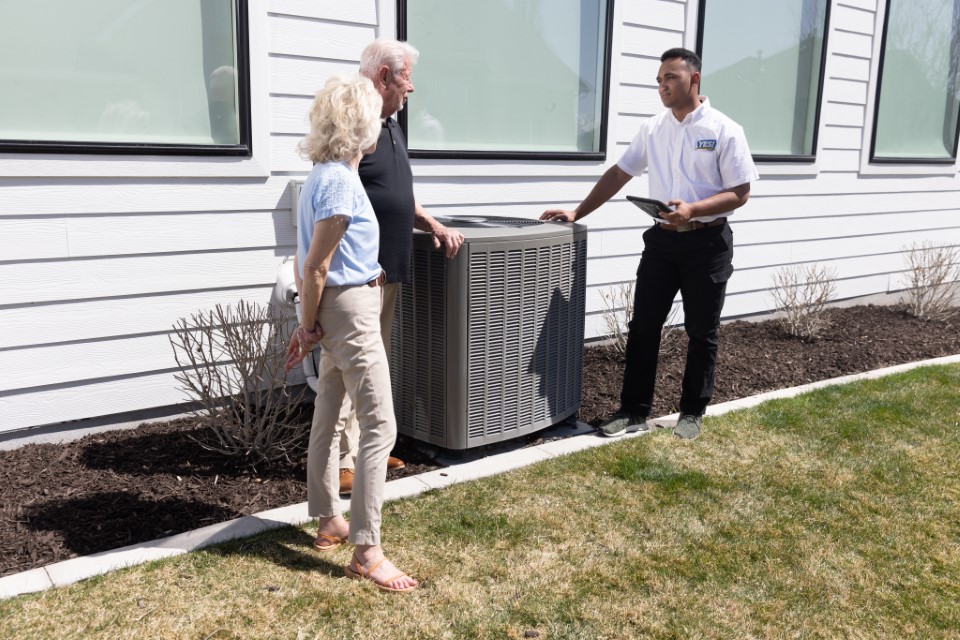Your Ultimate Guide to Air Conditioning
April 26, 2023

Ahh…that refreshing feeling of walking into an air-conditioned room. It’s cool and crisp and the perfect remedy for that scorching summer heat. Like many of our technological devices, we often don’t question the functionality behind air conditioning. And why should we? After all, it keeps us comfortable and productive throughout our daily routines.
But if you’re ever looking to replace or repair your air conditioning unit, it’s crucial to understand the basics to create a cool, healthy, and comfortable environment for your home. Keep reading as Yes! Yes! gives you the ultimate breakdown on air conditioning.
How Does Air Conditioning Work?
The way AC functions depends on the type of system you have, but most are made up of these three components:
- Refrigerant: This is a chemical blend found in either a fluid or gaseous state. It absorbs heat from the environment and can provide refrigeration when combined with compressors and evaporators.
- Outdoor/Condensing unit: This is a temperature-controlled device that lives outside your home. This includes the fan, compressor, condenser coil, and refrigerant.
- Indoor unit: The indoor unit carries the evaporator coil, which sits on top of the furnace inside your home. The coil absorbs the heat from your living space, creating cool, dehumidified air.
The outdoor and indoor units work together to send the refrigerant back and forth from the outside condenser coil to the inside evaporator coil.
Now, there are two typical types of AC units you’ll run into: central and ductless air conditioning systems.
Central Air Conditioning System
The most common way to cool a home is through central air conditioning. When the temperature inside your home rises, the following happens:
- Your thermostat sends a signal to the circuit board in your furnace, calling for cold air.
- The circuit board turns on your furnace/blower motor inside your home and the fan and compressor outside of your home. The blower motor draws in warm air through your home’s ductwork.
- This air from the ductwork is blown through the evaporator coil, which turns warm air into cold.
- The cool air is dispersed throughout your home through the air vents.
- The refrigerant in your AC absorbs the heat from the indoor air, as it flows through the evaporator coil and transitions from a low-pressure gas to a high-pressure liquid.
- The heated refrigerant is pumped to the condenser. This condenser blows outside air across a different set of coils, which removes the heat from your home that was absorbed by the refrigerant. The refrigerant is then cooled down, turned back into a low-pressure gas, and returned into the home.
- This process/cycle continues until the desired set temperature on your thermostat is achieved.
Central AC is a good fit for those looking for:
- Convenience. You can control the temperature in all rooms of your home by simply adjusting your thermostat.
- Effective cooling. Central AC keeps your entire living space cool—not just a few rooms.
Cleaner air. People who have allergies or are concerned about their indoor air quality can find solace with central AC. They also promote good indoor air quality with their air filters that capture pollutants and allergens in the air.
Ductless Air Conditioning System
A ductless, or mini-split air conditioning system, works like a regular central AC system but without the ductwork. This means that the indoor unit is in the room that it’s cooling. Typically mounted on the wall in a particular area, the indoor unit pulls in warm air from the room it’s in and blows cold air right back into the room.
Multiple indoor units can connect to a single outdoor unit to provide air conditioning to your entire home. And with multiple indoor units, you can set different temperatures for each area/room in your home.
Widely regarded for its flexibility, ductless AC can be ideal for the following situations:
- If your home does not have ductwork. Older homes often do not have ductwork to support central AC.
- If you’re trying to downsize the efforts of your home. Maybe you have a few rooms that you aren’t using, but you still want to maintain a decent, healthy room temperature in them. Installing ductless AC can help you set unique settings for these specific rooms.
- If you want to give support to a room with specific cooling problems. Have a guest bedroom on the top floor that’s always hot no matter what? Installing a ductless AC can alleviate this situation and help your loved ones feel more comfortable during their stay.
- If you want to meet multiple needs. If your family or employees are fighting over the thermostat, going ductless is a great option to create independent temperature zones in different areas of your home or building.
How Do I Maintain My Air Conditioner?
To ensure that you’re keeping your home safe and comfortable, it’s crucial to conduct regular air conditioning maintenance. Not only will you save on money and energy, but you’ll also extend your AC system’s lifespan. So give your AC some much-needed attention and love by getting it inspected at least once a year. This process involves:
- Cleaning or replacing your filters. There are several recommended AC filters such as fiberglass, pleated, electrostatic, and HEPA that are great to use. The key is finding one that can weed out the smallest particles, while still allowing clean and maximum airflow throughout your home. Combining them with an indoor air purifier can effectively keep contaminants out of your system.
- Evaluating your refrigerant levels. If you find that your home isn’t producing as much cold air as it used to, the temperature you have set is never reached, or you hear a hissing or bubbling noise, it could mean that your refrigerant needs refilling.
- Lubricating your motors. If your motor hasn’t been lubricated, this can lead to overheating. You can tell if your condenser motor is overheating by placing your hand on top of the AC unit. If it’s excessively hot, there’s likely a problem with your system.
Checking your thermostat’s calibration. Your thermostat is the main interface between you and your AC system, so you want to make sure that it’s in good shape and accurately communicating your home’s temperature. You can start by placing an accurate thermometer on the wall next to your thermostat. Wait about 15 minutes and check the temperature reading on both devices. A difference of a few degrees is fine, but anything beyond that means your thermostat requires service.
What To Do if My AC Stops Working?
If you find that your AC system has lost its cool, take time to go through the following troubleshooting air conditioner guide and checklist:
1. Check Your Thermostat
Make sure your thermostat program settings are correct, that it’s set to cool and not heat. Also, check the batteries to make sure they’re in good shape.
2. Check Your Vents
Make sure all of your vents are open. If one is closed or blocked, this can make it challenging to cool your entire home.
3. Check Your Circuit Breaker
Your problem might just be solved with a simple switch. It’s very common for circuit breakers to trip, so make sure the right circuit is switched on.
4. Check Your Filter
If your filter is dirty and clogged with debris, you won’t get any airflow. The build-up can also cause dirt to accumulate in your ducts and your evaporator coils to freeze, which can clog the air even more.
5. Check Your Air Ducts
If you have access to your ducts, look for any visible tears and make sure that the joints are sealed well. You can close up any leaks with foil-faced tape or by applying mastic.
If you’re not comfortable dealing with large and costly electrical equipment on your own, or if you’ve gone through the steps and find you need further assistance, there are quality air conditioning companies that can resolve your AC issues with a reliable team of experts.
What Should I Know Before Having My Air Conditioner Installed?
So you’re thinking about having a new AC system installed. There are a few important things you should consider before diving into air conditioning replacement and installation.
1. Get Your Old System Thoroughly Inspected
It only makes sense to have your old AC system evaluated to see if it needs repair rather than replacing. This can also help you compare prices to determine which route is more cost-effective in the long-run. So be sure to get detailed estimates before making any decisions.
2. Understand Your Filter and Thermostat Options
While speaking with technicians, ask them to disclose all of your options up front, so you understand what they are and can make proper decisions based on your needs. For example, most AC systems are compatible with disposable and permanent or washable filters. So you want to think about whether you want to clean your filters or just change them out every few months.
Ask a technician what your thermostat options are with your potential new AC system. It’s important that the compatible thermostat is easy for you to use and provides convenient options.
3. Understand the Time Frames
The time it takes to install an air conditioner varies across makes and models, so ask the AC business to provide a breakdown of how long your AC installation will take to complete. Especially if the summer heat is coming in fast, you don’t want to go on without a cooling system for too long. Not to mention, you don’t want to inconvenience your family/employees for an extended period of time either.
4. Find Companies that Promote Energy Efficiency
Central air conditioners run on electricity. When it runs a lot during the summer months, it can consume a lot of energy, so it’s important you find air conditioning services that specialize in energy efficiency. These services ensure that:
- Your home is properly insulated. A properly insulated home will keep that valuable cold air from leaking outside, reducing the cost of maintaining your home’s temperature.
- Offer a smart thermostat. Smart thermostats like the Nest Learning Thermostat are an efficient and smarter way to save money and energy when it comes to maintaining a comfortable temperature-controlled home. An AC that stays on all the time is one that’s using a lot of energy (and costing you money), and smart thermostats can help keep you cool when you need it without running your system 24/7.
Beat the Heat by Contacting Us
Don’t let the heat stop you from enjoying your summer. Be sure to use this air conditioning guide to help you navigate and identify areas of your AC system that might need further fine-tuning.
Here at Yes!, we have a team of highly-skilled technicians who’ll install a brand new AC unit or repair your current one with the utmost care and attention at a competitive price. So reach out to us to see what our AC experts can do to upgrade your system. We proudly serve Las Vegas, Salt Lake City, and the surrounding areas.
Last Updated: May 25, 2023
